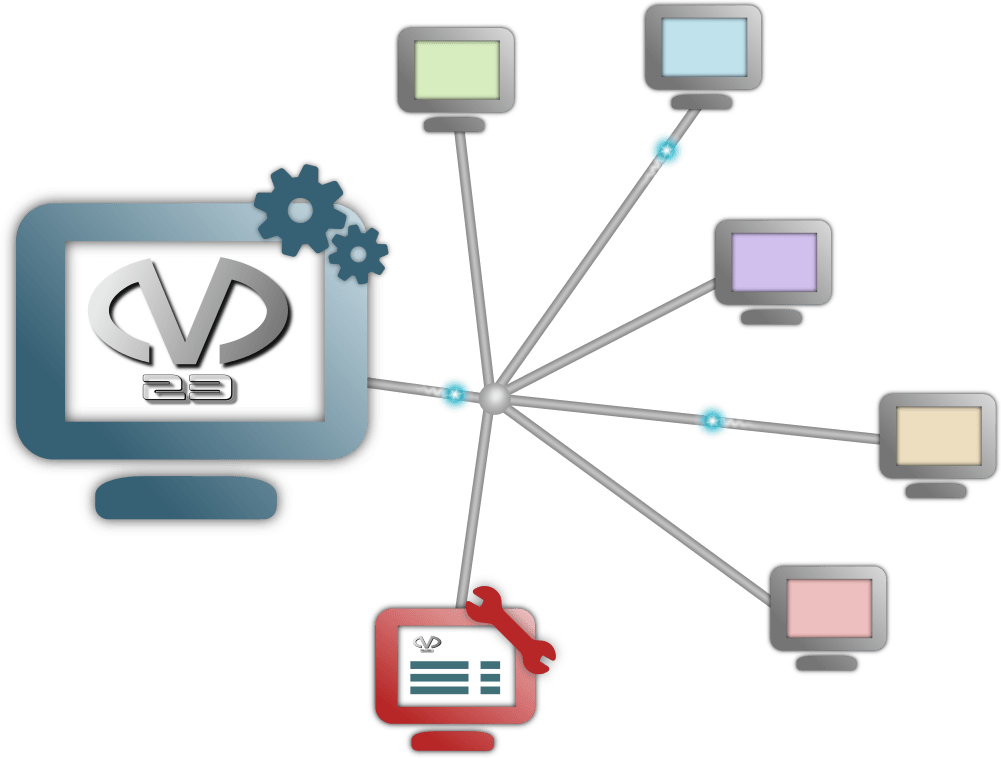
Network Deployment for Linux
Nur einen Moment... / Just a moment...
Freie Software und Bürgerrechte benötigen Deine Aufmerksamkeit!
Handeln gegen Überwachungsstaat und Softwarepatente
Wenn Du auch in Zukunft in einem Staat leben möchtest, der nicht dem Überwachungsstaat aus "1984" gleicht, und/oder Du möchtest, dass weiterhin jede(r) Software entwickeln und vertreiben kann, gibt es verschiedene Möglichkeiten, sich zu engagieren. wir möchten Dir diese fünf Organisationen empfehlen:
Free software and civil rights need your help!
Act against police state and software patents
If you don't want to live in a state à la "1984" and you want that development and distribution of software should remain legal for everyone, then you have different possibilities to get into the act. We would like to recommend these five organisations:
This page gives you all the information that is necessary to install your own m23 server. m23 can be installed in different ways. The following chapters are containing all necessary instructions for each method. You should read the chapter "First steps with your m23 server" in the user manual after the installation.
Have fun!
Overview
 Server installation ISO
Server installation ISO
You can download the server installation ISO image from the m23 page and burn it on a DVD/CD (please use a rewritable medium to save resources and reduce toxic waste). The ISO installs a minimal Debian operating system and after the 1st boot from hard disk the m23 software is post-installed via the internet.
Suitable for
- Bare-metal installation on a dedicated server
- Installation in a full virtualization (e.g. VirtualBox or KVM)
Requirements
- Internet connection for installation (and operation)
- Static IP address
- Network card supported by Debian (network bridge if necessary)
- Minimum 25 GB HDD/SSD and 1 GB RAM
Additional informationen
- Download the Server installation ISO image from here.
- German Video-Tutorial: m23-Server installieren: ISO
Hint 1: The m23 Server installation ISO is developed for simpler setups and gives you only a fewer server configuration options (the functional range of m23 remains untouched). If you prefer a more complicated server configuration or your hardware is not supported, you need to install Debian with a Debian installation CD and follow the instructions under Debian packages afterwards.
Hint 2: The server installation ISO file can also be installed directly without previous burning in a virtual machine, like for example QEMU, KVM or VirtualBox. You can find some further hints about this here: "Virtual machines".
Hint 3: If you don't have a CD/DVD drive in your server, you can use the tool UNetbootin to convert the m23 server installation ISO into a bootable USB stick.
 Debian packages
Debian packages
The m23 server installation packages are CPU architecture independent and can thus be installed on any server for which a Debian version (e.g. amd64, i386 or arm64) is available. m23 works best if m23 can use the server exclusively and it is not used for other purposes at the same time.
Suitable for
- Distributions: Debian: 10, 11, 12. UCS (Univention Corporate Server): 5.x
- Bare-metal installation on a dedicated server
- Installation in a full virtualization (e.g. VirtualBox or KVM)
- Installation in a container virtualization (e.g. LXC)
Requirements
- Internet connection for installation (and operation)
- Static IP address
- Network card supported by Debian (network bridge if necessary)
- Minimum 25 GB HDD/SSD and 1 GB RAM
Installation
To install m23 on Debian or UCS, run the following (after checking the script carefully) as root:
wget -T10 -t10 https://goos-habermann.de/m23inst.sh -O m23inst.sh && bash m23inst.sh
Caution: Be sure to make a backup before installing. Installing can lead to total data loss.
Hint for Raspberry Pi: Please also install the official Debian on the Raspberry Pi and not the fork Raspbery Pi OS. You can download tested Debian Raspberry Pi SD card images from https://raspi.debian.net/tested-images. For information on setting a static IP before writing the SD card, see the German video "Raspberry Pi OS"-Images anpassen.
 Univention Corporate Server (UCS)
Univention Corporate Server (UCS)
Under UCS you can install the m23 app directly via the Univention App Center:
Release date: It is possible that m23 as UCS m23 app – due to the complicated and error-prone release procedure at Univention – will be released significantly later than the other m23 versions. If you want to use m23 on UCS, you can install the m23 server software via the m23 Debian packages. The packages provided in this way are usually more up-to-date than those of the UCS m23 app and offer the same range of functions.








